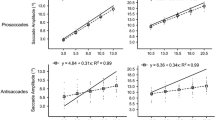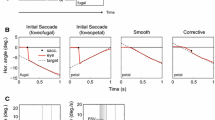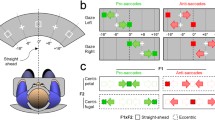Abstract
In this study we examined the performance of human subjects in three oculomotor tasks: a visually guided saccade task (VST), a simple antisaccade task (SAT) and a mirror antisaccade task (MAT). The stimulus presentation was identical for all three tasks, and the differentiation of the tasks was based on the instruction given to the subjects. Subjects were instructed to either look at a visually presented target location (visually triggered saccade task), or to look at the opposite direction of the visually presented target (simple antisaccade task) or finally to look at the mirror location opposite to the location of the visually presented target (mirror antisaccade task). The loading of the simple antisaccade task with the addition of the amplitude requirement did not affect the percentage of directional errors but slowed down the onset of antisaccade execution by 19 ms. The amplitude of the directionally correct antisaccade in the mirror antisaccade task showed a significant distortion of the true mirror target location. This dysmetria followed the same qualitative pattern to that observed for the visually guided saccades, i.e., a near-target hypermetria together with a far-target hypometria, but both these features were exaggerated in the mirror antisaccade task. This distorted amplitude modulation of mirror antisaccade amplitude was completely lost in corrected antisaccades that followed a directional error.


Similar content being viewed by others
References
Abrams RA, Jonnides J (1988) Programming saccadic eye movements. J Exp Psychol Hum Percept Perform 14:428–443
Allik J, Toom M, Luuk A (2003) Planning of saccadic eye movements. Psychol Res 67:10–21
Aslin RN, Shea SL (1987) The amplitude and angle of saccades to double-step targets displacements. Vision Res 27:1925–1942
Becker W, Jürgens R (1979) An analysis of the saccadic system by means of double step stimuli. Vision Res 19:967–983
Bell AH, Everling S, Munoz P (2000) Influence of stimulus eccentricity and direction on characteristics of pro- and antisaccades in non-human primates. J Neurophysiol 84:2595–2604
Evdokimidis I, Smyrnis N, Constantinidis TS, Stefanis NC, Avramopoulos D, Paximadis C, Theleritis C, Efstratiadis C, Kastrinakis G, Stefanis C (2002) The antisaccade task in a sample of 2006 young men. I. Normal population characteristics. Exp Brain Res 147:45–52
Findlay J, Walker R (1999) A model of saccade generation based on parallel processing and competitive inhibition. Behav Brain Sci 22:661–721
Gourtzelidis P, Smyrnis N, Evdokimidis I, Balogh A (2001) Systematic errors of planar arm movements provide evidence for space categorization effects and interaction of multiple frames of reference. Exp Brain Res 139:59–69
Gnadt JW, Bracewell RM, Andersen RA (1991) Sensorimotor transformation during eye movements to remembered visual targets. Vision Res 31:693–715
Hallett PE (1978) Primary and secondary saccades to goals defined by instructions. Vision Res 18:1279–1296
Hanes DP, Carpenter RH (1999) Countermanding saccades in humans. Vision Res 39:2777–2791
Huttenlocher J, Hedges LV, Duncan S (1991) Categories and particulars: prototype effects in estimating spatial location. Psychol Rev 98:352–376
Kapoula Z (1985) Evidence for a range effect in the saccadic system. Vision Res 25:1155–1157
Massen C (2004) Parallel programming of exogenous and endogenous components in the antisaccade task. Q J Exp Psychol 57:475–498
Ottes FR, van Gisbergen JAM, Eggermont JJ (1984) Metrics of saccades responses to visual double stimuli: two different modes. Vision Res 26:857–873
Soechting JF, Flanders M (1989) Sensorimotor representations for pointing to targets in three-dimensional space. J Neurophysiol 62:582–594
Sparks DL (1988) Neuronal cartography: sensory and motor mapsin the superior colliculus. Brain Behav Evol 31:49–56
Visscher K, Viets E, Snyder L (2003) Effects of training on memory-guided saccade performance. Vision Res 43:2061–2017
White J, Sparks DL, Stanford T (1994) Saccades to remembered target locations: an analysis of systematic and variable error. Vision Res 34:79–92
Author information
Authors and Affiliations
Corresponding author
Rights and permissions
About this article
Cite this article
Evdokimidis, I., Tsekou, H. & Smyrnis, N. The mirror antisaccade task: direction–amplitude interaction and spatial accuracy characteristics. Exp Brain Res 174, 304–311 (2006). https://doi.org/10.1007/s00221-006-0462-2
Received:
Accepted:
Published:
Issue Date:
DOI: https://doi.org/10.1007/s00221-006-0462-2




